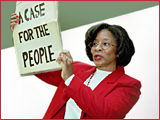RELIVING A 1969 RACIAL CLASH
The Black Students Who Changed Rutgers
Feb. 12, 2001
By Hoag Levins
CAMDEN, N.J. -- The 1960s were a historical watershed for African Americans and Marie M. Downes appeared at the Camden County Historical Society yesterday to help a standing-room-only audience remember that era of turmoil and trauma.
Now Director of the West Deptford Public Library, her presentation about the county's civil rights movement was part of a series of events sponsored by the Society to mark Black History Month.

|
| Photo: Hoag Levins. |
|
Marie Downes displays a 1968 student newsletter during her talk.
|
|
Downes grew up in Camden and graduated from Camden High in 1965 before going on to Rutgers-Camden. There, she was one of only 17 blacks in a student population of 1,100 on a campus located in the heart of what had become a predominantly black city.
Decade of confrontations
She had come of age in a decade of constant confrontations between blacks and the white political establishment. Activist leaders like Stokley Carmichael and H. Rap Brown were openly calling for a black revolution. And, in the 1968 event that set fire to hearts and inner cities from coast to coast, Martin Luther King was assassinated in Memphis.
As a student at Rutgers-Camden, Downes became a follower of the charismatic Charles Poppy Sharp, a firebrand who in 1968 founded the Black People's Unity Movement (BPUM) and became Camden's version of H. Rap Brown.
One of the neighborhood spin-offs of the BPUM was the BSUM, the Black Students Unity Movement organized by students at both Rutgers-Camden and what was then known as Glassboro State College (now Rowan University).
"We were very vocal against injustice in the black community. We wore our Afros, we wore our daishikies and we picketed businesses that discriminated against black people."
'The Black Observer'
"We wanted to educate and motivate people so we formed a newsletter called The Black Observer," she explained. The publication was produced by mimeograph; its larger headlines were drawn by hand for lack of typesetting facilities.
She displayed one the of the early issues, tapping on the headline, "And You Eat It?"
"We were concerned about local issues, like supermarkets," shesaid, reading the 1968 article aloud:
"Those of us who live in South Camden usually shop in the white-owned markets located on Broadway. There was once a day when we would go to one market rather than another because it was cleaner. Displays were interesting and neat and the quality of food was better. But now our choices are gradually being eliminated because it seems the markets are competing with each other to see which can be the dirtiest, untidiest one offering the rottenest food at the highest prices to black buyers."
On a larger stage in 1969, Downes and the 23 others in the BSUM submitted a list of 24 demands to the administration at Rutgers-Camden. The demands included the removal of racist faculty members, establishment of an urban education department, the hiring of more blacks, selection of a suitable African American to fill a new position as admissions director for minority students, creation of a program to recruit minority students, creation of a black dormitory and recreation building, the opening of campus

|
|
Students demanded sweeping changes at Rutgers' Camden campus.
|
|
facilities to members of the surrounding Camden community, and a change in the name of a new university library addition to honor Paul Robeson.
Seized university building
When it seemed that BSUM demands weren't being taken seriously, Downes and the other students seized control of a university building. The action put them on the front page of the Feb. 10, 1969, Courier Post.
"My mother was horrified," Downes told the audience, smiling broadly.
Ultimately, the university agreed to 18 of the demands and today, 32 years later, Rutgers' broad program of ethinic studies and minority scholarships help make its Camden campus a model of racial and cultural diversity.
Even more telling is the fact that, three decades later, the Rutgers University Web site maintains a section about the BSUM's protests as well as the group's original list of demands. The historical archive is used as a teaching aid in various ethnic studies courses. In attached forums, contemporary students debate the events of 1969.
"That was our biggest accomplishment as members of the BSUM -- being the catalyst for change," Downes said. "Then, as now, it's important for individuals to take a stand in order to make things change for the better. If you don't tell institutional, society and commercial leaders what's wrong, they have no reason to reassess their actions or change. When people get complacent and just go along with whatever is done to them, they become part of the problem. It's easy for the establishment to tell itself 'everything must be OK -- because nobody is complaining.'"
Look back proudly
Downes indicated that the many people across the country who took part in civil rights protests in the 1960s and 1970s can now look back with pride on what they helped achieve.
The career librarian also noted some quieter, less obvious triumphs. As a college student in the 1960s, she pointed out, it was particularly hurtful not to be able to find many books written by black authors or books about black subjects.
"Today, however," she said, "we are blessed with so manyn books by African American writers and books about African American themes. It's amazing to go to Amazon or Barnes and Noble on the Internet and see how many titles come up for the topic, 'civil rights.' It is a good measure of how much has changed and how far our country has come."
A children's story for the ages
She ended her presentation by reading a children's story that contained a larger message for all. It was the tale of a small black girl in the deep South on the eve of the social explosions of the 1960s.
The little girl took her first walk to town alone and, with the naievete of the young, didn't understand the meaning of the water fountain sign, "Whites Only." Assuming it meant she could only tread on the wooden step and drink if she were wearing white socks, she removed her shoes, stepped up in her white socks and drank.
The act precipitated a tense racial showdown in the crowded town square. Inspired by the little girl, a long line of black adults removed their shoes, stepped up and, for the first time, drank water from the public fountain in the center of their own community.
"Three decades ago as university students, and much like the little girl in the story," said Downes, " we learned that if the individual doesn't summon the courage and step forward and take action when action is needed, then nothing will change."
| 






